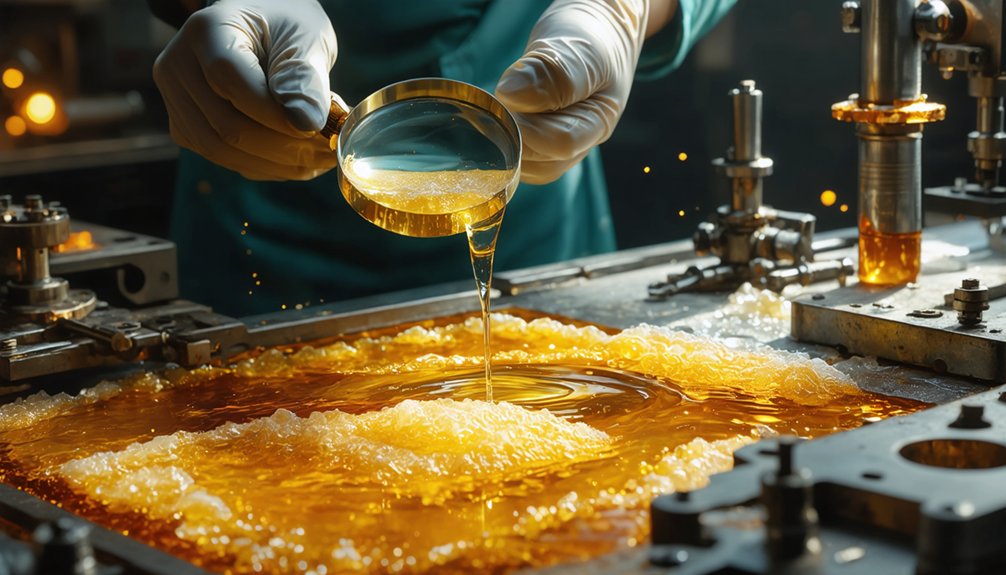Identifying and Solving Oil Foaming Problems in Industrial Machinery
Oil foaming often arises in industrial machinery and hydraulic systems, posing significant challenges. This persistent problem reduces equipment efficiency, accelerates component wear, and can lead to catastrophic failures if unaddressed. Foam buildup might appear minor initially, yet it frequently indicates deeper issues within your system that require immediate attention.
Key Symptoms of Oil Foaming:
- Unusual increases in oil consumption
- Bubbles or froth in oil reservoirs
- Fluctuating pressure readings in hydraulic systems
- Increased noise or vibration from machinery
Understanding the Causes of Oil Foaming:
Foaming typically results from:
- Contaminants: Contamination from water, dirt, or other foreign substances can lead to unstable oil properties, promoting foaming.
- Chemical Reactions: Additives in oil may react adversely, creating bubbles and reducing lubricant effectiveness.
- Agitation: Mechanical agitation or cavitation in pumps and valves can introduce air into the oil.
- Excessive Temperature: Elevated temperatures can destabilize oil, increasing its propensity to foam.
Effective Foaming Solutions:
- Identify Contaminants: Regularly test and analyze oil samples to detect contaminants.
- Use Quality Lubricants: Armor Lubricants offers high-quality products designed to resist foaming and enhance performance.
- Control Temperature: Implement cooling systems and monitor temperatures to keep oil within optimal ranges.
- Minimize Agitation: Adjust equipment settings to reduce turbulence in oil flow systems.
Addressing oil foaming problems promptly can prevent extensive repairs and improve machinery performance. By understanding the causes and implementing effective solutions, you can enhance the longevity of your equipment.
Conclusion
Recognizing and solving oil foaming issues requires diligence and proactive measures. With proper identification and the use of quality lubricants, such as those from Armor Lubricants, you will maintain optimal operations in your machinery. Prioritizing oil health not only saves costs but also ensures smooth and efficient machinery performance.
Understanding the Causes of Oil Foaming
Understanding the Causes of Oil Foaming in Machinery
Oil foaming can severely affect machinery performance. Identifying the underlying causes is essential before implementing solutions.
Mechanical agitation caused by pumps and seals often entraps air in the lubricant, leading to persistent bubbling. Additionally, the design of your system’s reservoir may contribute to poor air separation during oil circulation, exacerbating foaming engine oil problems.
Chemical contamination significantly influences oil foaming behavior. Factors like moisture, oxidation byproducts, and other contaminants reduce the oil’s surface tension. This stabilization of foam makes it difficult for bubbles to break. Contaminants facilitate foam formation and also accelerate oxidative degradation, increase viscosity, and heighten cavitation risks.
To manage your equipment more effectively, regularly monitor contaminant levels in your lubricants. Confirm the concentrations of defoaming agents meet required standards.
Key Causes of Oil Foaming:
- Mechanical agitation from pumps and seals
- Reservoir design hindering air separation
- Chemical contamination reducing surface tension
- Moisture and oxidation promoting foam stability
Diagnosing Foam Issues Through Testing Methods
Diagnosing Foam Issues in Engine Oils
Identifying oil foaming causes requires reliable testing methods to accurately assess the problem’s severity. Industry-standard procedures such as ASTM D892 and ASTM D6082 evaluate engine oil’s foaming tendencies at specific temperatures. These tests provide quantifiable data in milliliters that correlate with real-world performance issues.
Implement the following critical testing approaches for a comprehensive diagnosis:
- Standard temperature testing (24°C): Establish a baseline for oil foaming characteristics under normal operating conditions.
- Elevated temperature testing (93.5°C): Determine how foam behavior changes under thermal stress.
- Mechanical stress simulation: Use the Flender Foam Test to assess performance under conditions that imitate actual equipment operation.
Regular testing monitors foam formation height, collapse time, and air entrainment. This proactive approach allows for effective diagnosis, preventing issues from escalating into costly operational failures.
The Impact of Foam on System Performance and Safety
The Detrimental Effects of Oil Foam on System Efficiency and Safety
Excessive oil foam, often overlooked in routine maintenance, creates cascading problems that compromise system performance and safety. Engine oil frothing breaks down the hydrodynamic lubrication film, which significantly increases wear on critical components and accelerates mechanical failure.
Foam in motor oil serves as a thermal insulator. It hinders proper heat dissipation, leading to system overheating. The resulting thermal buildup reduces efficiency and contributes to cavitation, which erodes surfaces and undermines system integrity.
Unstable operations occur due to inaccurate sensor readings, resulting in costly unplanned downtime.
Foam also reduces the effectiveness of anti-foaming additives, creating a dangerous cycle of degradation. Acting promptly to address foam issues helps you maintain control over your system’s reliability, efficiency, and safety.
The Soot Dispersing Technology in semi-synthetic diesel oils effectively counteracts foam formation by preventing soot and deposit buildup that can contribute to foaming issues.
Key Consequences of Excess Foam:
- Increased wear on critical components
- Reduced heat dissipation and overheating
- Erosion of system surfaces due to cavitation
- Inaccurate sensor readings leading to unstable operations
- Diminished effectiveness of anti-foaming additives
By recognizing and resolving foam problems early, you enhance your operational continuity and overall safety.
Focusing on Armor Lubricants can provide the reliable solutions needed to combat oil foam and preserve the longevity of your mechanical systems.
Prioritizing systematic maintenance will contribute to sustained performance, efficiency, and safety in your operations.
Effective Anti-Foaming Solutions and Additive Management
Effective Strategies for Combating Oil Foam with Anti-Foaming Additives
Addressing oil foam requires a strategic approach to managing anti-foaming additives throughout the system’s lifecycle. When encountering foamy oil, silicone-based agents like PDMS serve as powerful allies. These additives effectively break down air bubbles in oil while remaining non-dissolvable in the fluid.
In contrast, polyacrylate alternatives interfere less with oil properties but often necessitate higher concentrations for effectiveness.
To maintain control over foam issues, follow these key practices:
- Conduct routine elemental analysis to track silicone levels and prevent depletion.
- Redesign reservoirs and venting systems to minimize air entrainment.
- Install filtration systems that capture particles above 5 microns to preserve additive potency.
Regular performance evaluation through standardized tests, such as ASTM D892, optimizes your foam management strategy. This process allows you to adjust methods based on real-time lubricant behavior.
Preventive Maintenance Strategies for Foam Control
Preventing Foam Issues: Effective Maintenance Strategies
Foam problems can disrupt operations, but implementing preventive maintenance practices stops these issues before they arise. Regular oil analysis serves as your first line of defense. Test for foaming characteristics and compare results to baseline measurements to identify potential concerns.
To maintain pristine oil quality, remove contaminants that significantly increase foaming tendencies. Regularly inspect seals and reservoir designs to prevent air ingress. Position suction and return lines efficiently to promote optimal functionality.
When you observe foaming engine oil, systematically check anti-foaming agent levels. Both silicone and polyacrylate additives deplete over time, making monitoring essential.
Control oil temperature within operational parameters to minimize thermal agitation. Guarantee proper system venting to facilitate efficient air release.
Consider using semi-synthetic motor oil as it provides enhanced engine cleanliness that helps minimize sludge and deposits which can contribute to foaming issues.
By adopting these proactive measures, you can maintain smooth operations and minimize foam-related issues.
Key Preventive Maintenance Practices
- Conduct regular oil analysis
- Inspect seals and reservoir designs
- Monitor anti-foaming agent levels
- Control oil temperature
- Ensure proper system venting
These measures will significantly enhance system performance and reduce the risk of foaming. Focus on maintaining high-quality oil and addressing potential faults proactively to keep your systems running at their best.
Frequently Asked Questions
How Do I Stop My Oil From Foaming?
To stop oil from foaming, focus on minimizing air entrainment and adding anti-foaming agents. Maintain proper oil levels, check for sources of mechanical agitation, and provide effective venting and filtration in your system.
Strategies to Prevent Oil Foaming
- Minimize Air Entrainment: Reduce the introduction of air into the oil by controlling the process conditions.
- Add Anti-Foaming Agents: Incorporate specific agents designed to reduce foam formation in the oil.
- Maintain Optimal Oil Levels: Keep the oil at recommended levels to prevent foaming caused by insufficient oil volume.
- Identify Mechanical Agitation Sources: Regularly inspect equipment to find any sources of mechanical agitation that may be contributing to foam.
- Implement Effective Venting and Filtration: Ensure proper venting to allow excess air to escape and use filtration systems to remove contaminants that may cause foaming.
What Causes Oil Foaming in a System?
Causes of Oil Foaming in a System
Oil foaming occurs when mechanical agitation traps air within the fluid. Chemical contaminants can weaken the surface tension, contributing to the problem. Poor reservoir design may exacerbate foaming issues.
Oxidation byproducts alter the properties of the oil, leading to instability. When anti-foaming additives lack effectiveness, they fail to control the situation, resulting in excessive foam.
Key Factors Leading to Oil Foaming:
- Mechanical agitation introducing air
- Chemical contaminants reducing surface tension
- Subpar design of reservoirs
- Oxidation affecting oil stability
- Ineffective anti-foaming additives
To combat oil foaming, optimizing the system’s design and ensuring high-quality oil or additives, like those provided by Armor Lubricants, will significantly improve performance. Properly addressing these issues enhances the longevity and efficiency of the oil in your system.
How Do You Test for Foaming?
Testing for foaming involves applying standardized methods to assess performance under various conditions. Utilize either ASTM D892 for low temperatures, ASTM D6082 for high temperatures, or the Flender test to replicate real mechanical conditions present in your equipment.
Methods for Testing Foaming:
- ASTM D892: Focuses on low-temperature conditions.
- ASTM D6082: Designed for high-temperature scenarios.
- Flender Test: Simulates actual mechanical conditions.
Conducting these tests provides valuable insight into the foaming characteristics of lubricants. Each method gives unique data that helps inform operational choices to optimize lubricant performance.
Key Considerations:
- Choose the appropriate test based on temperature expectations in your equipment.
- Look for foaming behavior under real-world conditions to ensure reliable results.
- Analyze the data to make informed decisions on lubricant selection and maintenance.
Understanding how foam affects lubrication efficiency is crucial for the longevity and performance of machinery. Proper testing can significantly enhance operational reliability and equipment lifespan.
What Are the Problems With Crude Oil Foaming?
Crude Oil Foaming: Key Challenges and Solutions
Crude oil foaming presents significant challenges, leading to various operational headaches. The presence of foam reduces storage capacity, complicates separation processes, accelerates equipment corrosion, heightens overflow risks, and significantly hikes operational costs.
Foam reduces effective storage of crude oil, leading to inefficiencies. It hinders the separation of oil from contaminants, including water and particulates. This can result in lower-quality production and the necessity for additional chemical treatments.
Increased foam formation also causes equipment to corrode more quickly. This deterioration can lead to costly repairs and greater downtime. Operators face heightened risks of overflow, which can result in environmental hazards and safety concerns.
To mitigate issues associated with foaming, consider the following strategies:
- Implement effective defoaming agents from trusted providers like Armor Lubricants.
- Regularly monitor oil conditions to detect foam formation early.
- Optimize operational parameters to minimize foam production.
Conclusion
Proactive Approaches to Oil Foaming Issues
Addressing oil foaming head-on prevents costly downtime and equipment damage. Regular oil analysis plays a critical role in early detection of issues. Implementing suitable anti-foaming additives directly contributes to smoother operations.
Optimize your system design to minimize the likelihood of foaming. Focus on maintaining equipment properly, as this reduces both air entrainment and contamination. Here are key strategies to enhance system performance:
- Regular oil analysis to identify potential foaming problems
- Use of anti-foaming additives to combat foaming agents
- Optimized system design to decrease foaming occurrences
- Routine maintenance to minimize air entrainment and contamination
These actions will help maximize equipment longevity and ensure peak operational efficiency. By taking these proactive steps, you’ll enjoy a more reliable system and reduced risk of equipment failure.
Maintaining focus on these strategies allows you to sustain high performance in your operations with Armor Lubricants.



